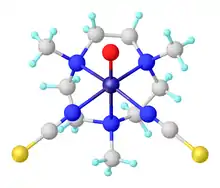In inorganic chemistry, titanyl refers to the functional group TiIVO, sometimes written TiO2+. The term titanyl is used loosely to describe many titanium(IV) oxide compounds and complexes. For example, titanyl sulfate and potassium titanyl phosphate contain TiIVO centers with the connectivity O-Ti-O-Ti. In heterogeneous catalysis, titanyl refers to a terminal oxo ligand on a surface titanium(IV) center.[2] There are a few molecular titanyl complexes where the oxo ligand is terminal, not bridging. In these cases the titanyl group is described as having a triple bond, i.e., Ti≡O.
References
- ↑ Axel Bodner; Peter Jeske; Thomas Weyhermueller; Karl Wieghardt; Erich Dubler; Helmut Schmalle; Bernhard Nuber (1992). "{Mono- and Dinuclear Titanium(III)/Titanium(IV) Complexes with 1,4,7-Trimethyl-1,4,7-triazacyclononane (L). Crystal Structures of a Compositionally Disordered Green and a Blue Form of [LTiCl3]. Structures of [LTi(O)(NCS)2], [LTi(OCH3)Br2](ClO4), and [L2Ti2(O)2F2(mu-F)](PF6)". Inorganic Chemistry. 31: 3737–3748. doi:10.1021/ic00044a015.
- ↑ John Meurig Thomas; Gopinathan Sankar (2001). "The Role of Synchrotron-Based Studies in the Elucidation and Design of Active Sites in Titanium−Silica Epoxidation Catalysts". Accounts of Chemical Research. 34: 571–581. doi:10.1021/ar010003w.
This article is issued from Wikipedia. The text is licensed under Creative Commons - Attribution - Sharealike. Additional terms may apply for the media files.
